|
present Book Reviews For Amateur & Avocational Archaeologists |
 |
|
present Book Reviews For Amateur & Avocational Archaeologists |
 |
Regional & General Artifact Identification
|
| Home | Gallery | Latest Finds | Back to Main Book Review Index |
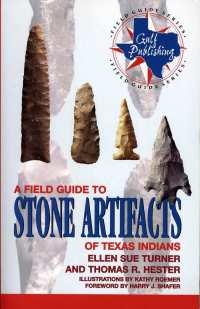
|
A Field Guide To
Stone Artifacts
of Texas Indians by Ellen Sue Turner & Thomas R. Hester Gulf Publishing First ed. with Gulf ISBN# 0-89123-051-3 paperback "What did I find?" If I only had a dime for every time I get asked that question! For artifacts found in Texas, there's really only one great reference to check, and that's this book. Easy to find at most large bookstores all over Texas, there's little doubt that you'll need to buy two copies--- one for the home and one to take out into the field. I used to like photographs of artifacts best for IDing, but over the years, have learned that it's the subtle flaking patterns you want to study, and drawings are much easier to interpret than pictures for this detail. This book is loaded with clear, accurate drawings of every type of lithic found in Texas. Accompanying the drawings are clear, concise descriptions for each type of lithic, with distribution shown on small maps. Read the introduction and get a quick summary of manufacturing techniques, context and chronology for Texas artifacts. The bibliography is a fantastic source for your future investigations. This book is a must-have for all parties interested in Texas lithics and is very economical to buy at only $17.95. Pick it up at Amazon for only $12.95! reviewed
by Bob
Wishoff
|
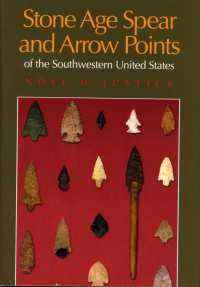 n 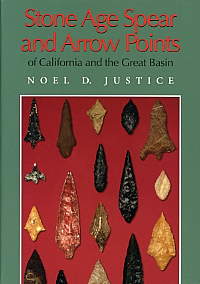 n 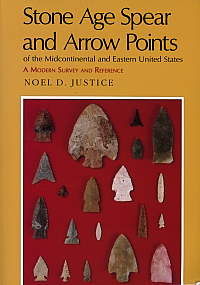
|
Stone Age Spear
Points and Arrow
Points of the Southwestern United States by Noel D. Justice Indiana University Press 2002 First ed. ISBN# 0-253-33912-X cloth hardback Stone Age Spear
Points and Arrow
Points Stone Age Spear
Points and Arrow
Points Perhaps the most unique item to mention about these books is the organizational concept by which the author does his point typing. He uses a cluster concept which looks at groups of points by their shapes, or morphology. The author uses this concept throughout the books, not only listing sets, or clusters, of points by their shapes, but also linking types together by the shapes of their pre-forms, which are illustrated along with the finished lithics. I find it difficult to accurately, succinctly summarize Justice's entire argument, but it seems very logical, and makes identifying point types much simpler than with other guides. I, personally, do not like most type descriptions, and welcome a new look at typology, one that could link types across the entire continent by their manufacturing technologies. So, therefore, a lot of each book's focus involves close looks at lithic manufacturing techniques employed by the various groups of Native Americans resident in the regions. Justice is incredibly meticulous and it is obvious that he's not only a typology expert, but also an expert at fashioning of tools of all types; he shows us how, too, lithic tools morphed as they were resharpened. What makes these books different is that they're not intended as true field guides, but instead, are books a researcher might reference in the lab while overseeing the results of an excavation where there are likely many forms of any particular type being found. To me, that makes them valuable references for any amateur or avocationalist seeking to get beyond the basic identification of lithic types by enlarging their scope of knowledge to include identification of intermediary forms. The books also include distribution maps, measurement charts (for all projectiles referenced in the books), color plates and a bibliography, all which will further aid the researcher or collector. The "Stone Age Spear Points and Arrow Points of ... " selection of books is the most thorough of any artifact series in print and a reference work for both amateur and professional researcher alike. Author Justice's ability to synthesize complex ideas into readable prose makes for a good read, too! These books normally retail for
between $29.99
- $39.99 each, but they are on sale and deeply discounted (get as much
as $16 off of each cover price) at the Indiana University Press
website!
Get to it by clicking here.
Indiana U. will put you on their mailing list when you order--->
great
deals on other books, too! reviewed
by Bob
Wishoff
|
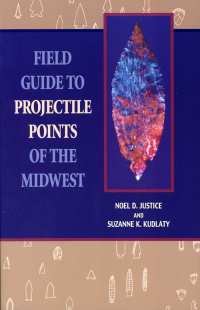
|
Field Guide To
Projectile Points
of the Midwest by Noel D. Justice & Suzanne K. Kudlaty Indiana University Press 2001 First ed. ISBN# 0-253-21463-7 paperback A handy little book by Noel Justice, this one's a much scaled down Field Guide, unlike the thick hardcover Stone Age Arrow Points books reviewed above... thin but useful to anyone hunting the Midwest with lots of drawings and descriptions of all Midwest projectiles. Probably the best bargain in my entire review list, IU Press is selling the book at an astonishing $3.00! (It was selling for $13.95) If you are like me and want all of the field guides from all over the US that you can afford, well, you won't be getting deals like this very often! To order this book from Indiana University, click here.
reviewed
by Bob
Wishoff
top of
page |
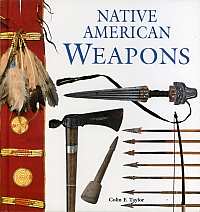
|
Native American
Weapons by Colin F. Taylor University Of Oklahoma Press 2001 First ed. ISBN# 0-8061-3346-5 cloth hardback Copiously illustrated, this little book will inform you of the nature and variety of every weapon utilized by Native Americans from prehistoric times through the late 19th century. The book is broken into chapters that focus on particular types of weapons: Striking Weapons, Cutting Weapons, Piercing Weapons, Defensive Weapons, and Symbolic Weapons. An extensive bibliography ends the book, allowing for much future inquiry by the reader. The author states, "The subject is vast; a focus on one cultural area alone, even one tribe, could produce a substantial study and so this volume must be viewed as a broad overview of a fascinating, but very extensive, topic." In addition to weaponry, the book contains commentary and illustration of body and horse armor and other materials associated with combat. Much discussion is made about the use of the atlatl, answering many questions you may have had on this topic. The book retails for $24.95, and
would make
a great addition to any library of Native American themed books. Native
American Weapons can be ordered direct
from
Oklahoma University Press by clicking here.
reviewed
by Bob
Wishoff
|

|
Dictionary of
Prehistoric Indian
Artifacts of the American Southwest by Franklin Barnett Northland Publishing 1991 First ed. Seventh Printing ISBN# 0-87358-120-2 paperback This little book is one of my favorite quick references. In dictionary form, it clearly defines what many items found in open campsites and cave are, and how they were used. What I like about it is that it lists many items that are kind of ephemeral, small things, widgets, we all scratch our heads over. It was the first place I'd ever seen a pottery anvil, for example. In 1955 Mr. Barnett and his wife, Joan, became interested in southwestern archaeology. A rather extensive library on Indian artifacts and archaeology was developed, with study during all available spare time. In this way, and in lieu of a formal education in archaeology, a lasting in-depth appreciation of the profession was built. Eventually, permission was obtained to explore and excavate prehistoric Indian sites on weekends. This lasted for years, with the two of them excavating and completely documenting over 500 prehistoric Indian rooms. During this period, Mr. Barnett was a supervisor of technical writing with Sandia Laboratories, Albuquerque, New Mexico. This book was written when they discovered how difficult all of the professional jargon was to easily understand. They wanted to define artifacts in simpler terms, and with photos, which keep descriptions to a minimum. It's quite simply a wonderful book to skim through, and a great resource when IDing odd items. another notch on the belt for all avaocationalists--- perhaps you, too, can author a great and lasting book! Getting harder to find new, Amazon has a host of used deals
from
$5: reviewed
by Bob
Wishoff
|
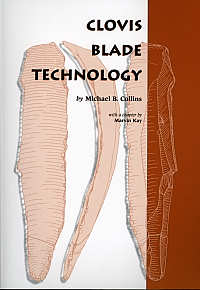
|
Clovis Blade
Technology by Michael B. Collins with a chapter by Marvin Kay University of Texas Press 1999/ 2002 1st paperback edition ISBN# 0-292-71235-9 Clovis is a technology, not a culture! Dr. Michael Collins will tell you that right off: We all make a mistake looking for some kind of homogenous ancient culture when we look at Clovis technology. Technology is dispersed, historically, among many peoples, and Clovis technology is no different. We are nearly totally ignorant of so-called Clovis lifeways and this book makes no attempt to add to this side of the inquiry, rather, it is an elegant discussion of the technology of Clovis blade manufacture, providing the reader with copious quantities of hard data presented within analytical and comparative contexts. Collins laments that most Clovis artifacts are found out of context, or were not well documented. Recently, he had the good fortune to excavate the now-famous Gault site, a definite exception to the rule: Years of research remain on what has proven to be one of the most well-preserved paleolithic sites in North America. Clovis Blade Technology is broken into three parts, the first of which introduces us to Blade Technology and Its Place in North American Prehistory and A Review of Clovis Lithic Technology in which the basic forms of blades (defining what a "true blade" is, for example) are shown as well as how they were made. Discussed also are the resultant "prismatic" cores. We learn that though many studies have been made, and much has been written about Mesoamerican blades, little has been explored relevant to North American examples. "What is Clovis?" is just one of the issues discussed in A Review of Clovis Lithic Technology. This section will answer, or put into focus, many of the questions about Clovis routinely passed between professionals, avocationalists and amateurs alike. Reading this part of the book, avocationalists and amateurs should be immediately alerted to just what is considered an important artifact for study (especially when found in context) as many of the Clovis blades could be passed over by the uninformed as uninteresting debitage. What you should be seeking for evidence of paleolithic occupation are flake blades and prismatic cores! This was the hot technology of the ancient world! The second part of the book is where we see hard data: Archaeology in action. Collins meticulously and methodically takes us through an examination of all of the finds from The Kevin Davis Site, a Clovis Blade Cache. Artifacts are measured and compared from every possible angle. Microscopic edge analysis is explained and charts are shown for all of the blades. All of this examination results in a pretty 'dense" read. You'll likely find yourself springboarding off to research some of the highly technical concepts introduced here and Collins supplies plenty of references to aid in this quest. The final section of the book compares blade data from many Clovis sites as well as including a discussion of caching behavior. Caching makes sense only when someone plans to return to a location, making the discovery of a cache an important find. The blade comparisons separate different degrees of context, keeping say, definitely Clovis site finds, seperate in comparison from those found in probable or indefinite contexts. Affecting the comparisons, however, were the different data sets and record-keeping from multiple excavators and researches. Not all of the researchers, for example, took note of each blade's curvature, making comparisons in this range possible only some of the time. The author makes note of the similarity of Clovis blades to those in southwestern Europe: Could this technology have come from other than Asia, as presently thought? Why is Clovis technology more common in North America than in South America? The Postscript illuminates us on the latest research news. If you are interested in paleolithic archaeology and lithic
technology,
this book is a must-read. Hard to find for awhile, it has finally been
re-issued as a paperback. Clovis Blade Technology
can be ordered directly from the publisher, for a web-special price of
only $20.07 (regularly $29.95), by clicking here. reviewed
by Bob
Wishoff
|
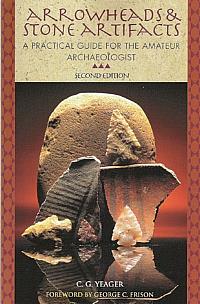
|
Arrowheads and Stone
Artifacts: A Practical Guide for the Amateur Archaeologist by C.G.Yeager Pruett Publishing Company 2000, 2nd Edition ISBN# 0-87108-912-2 Arrowheads and Stone Artifacts is a book that I read in its first edition as a novice “arrowhead hunter” and vastly appreciated for its simple, unassuming manner. It is good to see that Pruett Publishing has released a second edition of this elementary guide to surface hunting. The entry level avocationalist can easily be intimidated by the depth of many archaeologist-oriented texts, and even the more experienced can have a hard time finding material that is broad enough in scope to give a satisfying overview of just surface hunting. C.G. Yeager has produced an excellent book for both audiences. His excitement as an unabashed avocationalist is clear; the first illustration across from the title page is of the first point he ever found! In many ways this is a personal book, with photographs of his family on outings to seek out artifacts and stories of his experiences. The second edition even incorporates one chapter on his growing understanding of artifacts, evidenced in a chapter entitled Arrowhead, Spearpoint, or Knife? after a point he had changed his opinion about. This sort of candor in an author is refreshing and welcome evidence of a quality that every avocationalist should incorporate --- the willingness to keep on learning. Another addition to the second edition is information on the increasingly sticky subject of the legality of artifact collection, touching not only on antiquity laws but also building on a common sense code of ethics he establishes early on in the book. (Word of warning to site diggers however; he is adamant that sites should never be dug or excavated, and there is indeed validity to his admonition that valuable information is irretrievably lost in such activities.) The variety of materials utilized and the methods for working (and reworking) them are well covered. Yeager has included many of his own line drawings and photographs to illustrate hafting, basic terminology and a wide variety of artifact types. There are also seven pages of diagrams of basic projectile points, the period of their manufacture and geographical distribution, enough for basic identification purposes for the amateur though far from all inclusive. There are two practical chapters on where and how to hunt for artifacts, both of which are useful for the beginner and more experienced surface hunter alike. There are tips on how to use USGS and BLM maps which can be helpful in locating possible site locations and, in the case of BLM, avoiding falling afoul of federal laws. Flintknapping is briefly discussed with an eye to better understanding lithic technology. The importance of proper archiving and documentation of points is covered, as well as information on getting more involved in local archaeological organizations and activities. This updated basic introduction will be a welcome addition
to any
surface hunter’s library, and would make a wonderful gift for any
budding
avocationalist. It’s available directly from the Pruett
Publishing
website here for
$16.95. reviewed
by Charles
Swenson
|
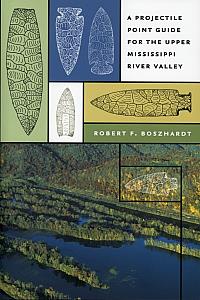
|
A Projectile Point
Guide for
the Upper Mississippi River Valley by Robert F. Boszhardt University of Iowa Press 2003 1st. ed ISBN# 0-87745-870-7 paperback "This guide would not have been possible without the cooperation of hundreds of individual artifact collectors who have shared their artifacts and information with me and my colleagues at the Mississippi Valley Archaeology Center over the past twenty years." So begins a slim (80pp), but packed-with-facts volume that without a doubt has the average collector in mind and tone. The book is filled with twenty-nine excellent line drawings of artifacts (no photographs) which duly serve to both illustrate the basic projectile shape, but also define the flaking styles with more precision than a photo. Each drawing is accompanied by a clear description of the point type, other possible names for the type, the type's age and distribution, usual materials the type is produced from, and finally, much appreciated further references for the type. In adddition to the type guide, there is a sample form included for site recording purposes. The author is very clear as to what is important about a find--- without location information, the find is useless, a mere rock. Boszhardt encourages all artifact finders to contact their local archaeologist. "Rest assured that archaeologists will not confiscate your artifacts, steal your site, or broadcast its location. You will be helping to piece together essential knowledge about the past. In return you will learn how old your artifacts are, what they are made of, and what they are used for." This book covers an area which is not usually covered in other artifact ID books. It is an excellent reference for anyone who lives in the area, or who wants a library of all regional artifact guide books. Order A Projectile Point Guide for
the Upper
Mississippi River Valley direct from the
publisher,
for $14.95 by clicking here.
reviewed
by Bob
Wishoff
|
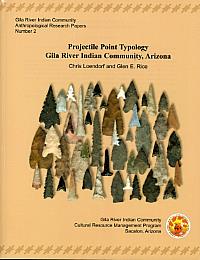
|
Projectile Point
Technology Gila River Indian Community, Arizona by Chris Loendorf and Glen E. Rice Gila River Indian Community CRM Program University of Arizona Press 2004 ISBN# 0-9723347-1-8 oversised paperback w/ supplemental CD An example of an excellent Cultural Resource Management project which involved only surface hunting, this artifact typology book is different from any of the others I’ve seen available. Begun in 1994, the Gila River Indian Community’s Cultural Resource Program undertook surveying 146,000 acres of the reservation, collecting nearly 1000 projectile points, fragments and preforms from the surface. Since much of the reservation has escaped the heavy development of other lands in the area (located near Phoenix, AZ) and is lightly farmed, “most of the large villages with associated public architectures, farmsteads, field houses, and specialized procurement locales located in the areas between [modern] villages remain relatively undisturbed.” The authors report on artifacts recovered from 195 of the
over 1000
recorded sites in the area. “The temporally sensitive stylistic
types
that comprise the collection demonstrate a long and complex use of the
landscape. As the reader of this volume will learn, the Gila River
valley
was not an empty niche during Archaic period times as is amply
demonstrated
by projectile point styles. At the other end of the chronological
sequence,
the projectile point dataset provides an unparalleled opportunity to
study
the evolutionary development of post-classic, proto-historic, and
historic
projectile point styles.” One thing that sets this book apart from other projectile studies is the inclusion, attached to the back cover, of a compact disk with images of the entire projectile assemblage! Not only are the pictures included, but also MS Excel spreadsheets are on the disk which includes all measurements (metric data) taken for each artifact. A highly interesting publication, not only for what is literally contained within, but also as an example of what can be determined by examining extensive assemblages of properly collected surface materials. Projectile Point Technology: Gila
River Indian
Community, Arizona can be ordered direct from the University of
Arizona Press for $19.95, by clicking here.
reviewed
by Bob
Wishoff
|
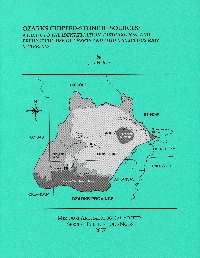 |
Ozarks
Chipped-Stone Resources: A Guide to the Identification,
Distribution,
and Prehistoric Use of Cherts and Other Siliceous Raw Materials.
Special Publications No. 8 It is divided into two parts—“Background” and “Resource Descriptions.” The four chapters in the first part are all quite useful. The introductory chapter presents: the history of identifying chipped-stone sources, a beginner’s discussion of silica-based raw materials (flint/chert, orthoquartzite/quartzite, siltstone/argillite, and rhyolite/silexite) in the Ozarks, sampling methods, and issues with modern flintknapping with its many related problems for those attempting to study the prehistoric past. Those problems include: the faking of artifacts, creating new sites with modern chipping debris, contamination of old sites, and destruction of prehistoric quarries. Ray does a fine job of presenting and discussing those problems with a growing hobby/industry.
“Ozarks
Physiography and Geology” (ch.2) and “Resource Availability,
Procurement, and
Use” (ch.3) are primers and more concerning the complex geology of the
Ozarks
and the ways various kinds of chipped-stone resources were obtained and
used by
the prehistoric and early historic inhabitants within and near the
Ozarks. This old land mass of generally
rugged
terrain, ancient rock formations, swift-flowing streams, and with an
overabundance of chert and other siliceous stones provided many useful
resources. Ray (p. 17) quoting Sauer
(1920:16) states, “The Ozarks contain probably more chert, or flint, as
it is
called, than any other similar area.” The five subprovinces of the Ozarks are: There are a variety of ways that chert and other silica-containing resources can be identified. Many types of analytical methods are described in chapter 4. They include: visual physical attribute analysis, fluorescence and luminescence analyses (including ultraviolet fluorescence and cathodoluminescence), geochemical analyses (including x-ray fluorescence, electron spin resonance spectroscopy, instrumental neutron activation analysis, and laser ablation inductively coupled mass spectrometry). This chapter is useful for anyone wanting some basic background information on any of these methods; although only the first will likely be used by most readers. This chapter also includes extensive information on heat treatment analysis. Deliberate heat treatment is usually applied to inferior-quality cherts with coarse to medium-grained textures. As Ray states, “High-quality fine-grained cherts need no heat treatment to improve knapping qualities” (p. 48). Of course, the down side of heat treatment is that it may decrease the fracture toughness of chert. Ray (as with virtually all archaeologists) uses the term “heat treatment” to identify chipped-stone materials which have been intentionally modified by heat to improve their workability during tool manufacture. However, Ray reserves the term “thermally altered,” as well as other terms, to refer only to the unintentional heat modification of these materials (p. 49). The reader should be aware that this latter term is also often used in a slightly different way by many other archaeologists. Sometimes it is relatively easy and sometimes it is quite difficult to determine if a given tool had been intentionally changed by heat or if it just happened to be altered inadvertently. Just as the useful term “projectile point” can be used to refer to either arrow points or spear points, many archaeologists prefer to use the term “thermally altered” in a manner so as to not distinguish between the deliberate and the unintentional changing of silica-rich stone by heat. The latter usage of the term is more all encompassing that Ray’s usage. It can then be a useful term in those specific cases where an archaeologist is unsure of the intention, or lack there of, to initiate a heat altering process on lithic materials or, in other words, are unsure of its “heat taphonomy.” Part II, “Resource
Descriptions” is
the heart, or the “meat and potatoes,” of the volume.
It is where the tremendous variety of
knappable raw materials is described. This
section includes 47 types of chert, six types of quartzite, three chert
breccias, two ironstones, and one each of basalt, silexite, argillite,
rhyolite, hematite, sandstone, and siltstone.
Within 331 pages, these 65 types (divided into 95
varieties) are
described in detail. They are generally
divided into individual chapters relating to geological “periods”
starting with
the oldest—Precambrian and Cambrian resources (four types), Ordovician
resources (nine types), Silurian and Devonian resources (nine types),
Mississippian resources (23 types), Pennsylvanian and Cretaceous
resources (six
general types), and Tertiary and Quaternary resources (two types). Each type is comprehensively described,
including:
its characteristics and variations,
geological
context, the effect of heat treatment, distribution, and prehistoric
use. The source area for each type is
shown on individual
maps of the Ozarks. No effort will be
made to list all these types or varieties within the confines of this
review. An appendix contains 28
color plates—illustrating
color, texture, and (in some cases) luster variations from 502
individual
lithic specimens. Frankly, it is amazing
as to the amount of information Ray has compiled on the subject. The only thing that this section lacks is the
chipped-stone resource flow chart that Ray (2008) produced on the back
of the
Chapter 11,
titled “Extraregional Resources,” is concerned with those chipped-stone
resources in the areas immediately surrounding the Ozarks plus two
exotic
resources—the Edwards chert from The last chapter (ch.12) is concerned with when and why procurement of different types of chipped-stone resources occurred. Ray presents evidence as to which of these resources were favored through time, during different segments of the archaeological record. Why did different cultural groups select certain cherts as opposed to other types? Why did this change during different time periods in different parts of the Ozarks? The volume answers the when and where, but the why, naturally, is rather speculative. From the Early/Middle Paleoindian to the protohistoric-historic, each archaeological period is discussed concerning the diachronic use of cherts and other silica-containing resources. This reviewer was pleasantly surprised to find the volume even covered the historic Osage use of chert for scrapers and native-made gunflints. Much valuable information for historic archaeologists is found in that section. Ozarks Chipped-Stone Resources: A Guide to the Identification, Distribution, and Prehistoric Use of Cherts and Other Siliceous Raw Materials is directed toward archaeologists; however, it should prove useful to geologists, earth scientists, and geographers as well. Readers will find a background in geology most helpful but certainly not mandatory for using this volume in sourcing artifacts. Depending on how much the reader already knows about the subject, the glossary could be very useful. It is a valuable reference for any professional or avocational archaeologist, or for any serious artifact collector interested in the chipped-stone resources within and adjacent to the Ozarks. It is the volume, and will be for many years to come, to consult on the subject. Jack Ray’s tour-de force may be ordered from the Missouri Archaeological Society at 901 South National Avenue, Springfield, MO 65897 or by calling with a credit card—(417)836-3773. It is well worth the shelf space in one’s library or laboratory. References Cited Ray,
Jack H. Sauer,
Carl O. |
| Home | Gallery | Latest Finds | Back to Main Book Review Index |